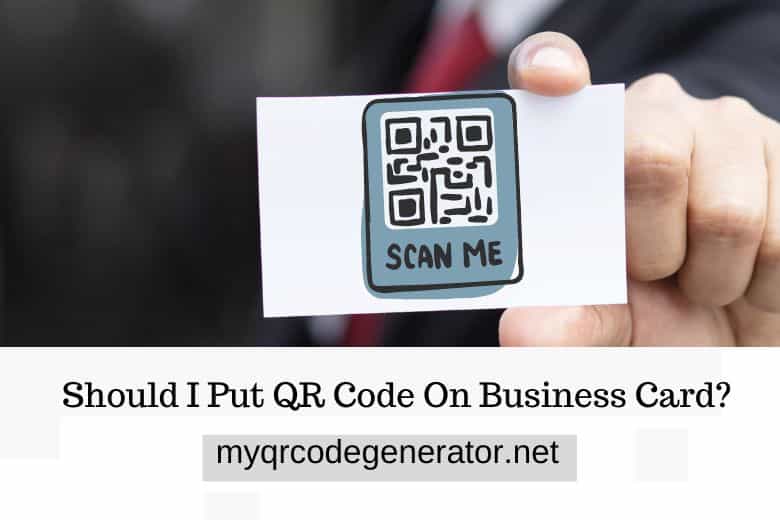Should I Put QR Code On Business Card? Unveiling the Pros, Cons, and Best Practices
In this digital age, where smartphones and tablets have become ubiquitous, the age-old tradition of exchanging business cards might seem a tad outdated. But what if there's a bridge between the tangible and the digital? Enter QR codes on business cards. The question now arises, "Should I put QR code on business card?" This article delves deep into the implications, advantages, drawbacks, and best practices associated with this trend.

Why Consider QR Codes on Business Cards?
1. Seamless Digital Integration
In today's digital era, the QR code serves as a bridge to an expansive virtual world. Scanning it can instantly transport an individual to a diverse range of digital platforms — be it a meticulously curated online portfolio, an engaging LinkedIn profile that showcases professional accolades, a sleek corporate website detailing services, or an intriguing video introduction that adds a personal touch. Such an integration not only streamlines information exchange but also amplifies the depth and breadth of one's professional introduction, transcending the confines of a traditional business card. Learn how to make a QR Code for Business Card in this article.
2. Environmental Benefits
Incorporating QR codes on business cards is more than just a digital innovation; it's a step towards eco-friendliness. These codes eliminate the need to overcrowd cards with excess information, thus significantly reducing the paper and ink consumption in the printing process. In essence, it's not just about creating a tech-savvy impression but also showcasing a commitment to sustainability.
3. Real-time Updates
In the dynamic world of digital media, QR codes present a revolutionary advantage: the ability to update embedded links without altering the physical artifact. Imagine handing out a business card and, over time, evolving your digital presence or portfolio. With traditional methods, a change would necessitate reprinting and redistribution. However, with a QR code, the same business card remains valid, effortlessly guiding scanners to your most recent accomplishments or updates. This not only offers convenience but also fosters sustainable practices by reducing wastage associated with frequent reprinting.
4. Tracking and Analytics
For modern businesses, the use of QR codes transcends mere digital accessibility; it's an avenue for rich data collection. By embedding QR codes on business cards, companies can glean real-time insights into scan frequencies, painting a vivid picture of potential client interest. This, in turn, offers a strategic edge, enabling businesses to tailor follow-up interactions more effectively and identify emerging networking trends. Leveraging such data-driven approaches, businesses are better poised to cultivate genuine leads, ensuring no opportunity goes unnoticed.
Potential Drawbacks and Concerns
1. Accessibility Issues
Accessibility remains a pertinent concern when integrating QR codes into business cards. Despite the surge in smartphone usage, a considerable segment of the population either doesn't own one or lacks the know-how to efficiently scan a QR code. For instance, older generations might find this technology daunting, potentially hindering communication. Moreover, according to a Pew Research study, not every demographic has equal access to such digital tools, emphasizing the importance of considering all audiences when relying on QR-enabled interactions.
2. Over-reliance on Digital Platforms
Over-reliance on digital platforms can pose unforeseen challenges. For instance, if a business card's QR code directs to a webpage and that site experiences downtime, the code instantly loses its utility, rendering the networking effort fruitless. This dependency underscores the importance of ensuring digital platforms' reliability and stability.
3. Perception of Being Impersonal
For many, the traditional exchange of business cards fosters a personal connection, a tactile memory of a new acquaintance or potential partner. Introducing QR codes, while technologically advanced, might be perceived as reducing this interpersonal touch, leaning heavily on digitization. This shift could create a barrier for some who value the organic essence of networking. According to a study by Harvard Business Review, human connections in business often hinge on authenticity; thus, a digital code might inadvertently dilute that genuine moment of introduction.
Best Practices: Incorporating QR Codes Effectively
1. Positioning and Size
Ensure the QR code is of an adequate size and is placed where it doesn't overshadow other vital information.
2. Test the Code
Before printing, always test the QR code with multiple devices to ensure it works seamlessly.
3. Provide a Call to Action
Beside the QR code, provide a small instruction like "Scan to view my portfolio" so that the recipient knows what to expect.
4. Keep a Good Balance
Remember, the QR code is an addition, not a replacement. Ensure that essential details like name, designation, and contact number are still prominent.
The Verdict: Should You Put a QR Code on Your Business Card?
In a world rapidly moving towards digitalization, integrating QR codes in business cards offers an innovative approach to networking. While they undoubtedly provide various advantages, it's crucial to weigh these against the potential downsides and use them judiciously.
For those who frequently network in tech-savvy circles or industries like digital marketing, design, or IT, QR codes can be a boon. However, if your primary contacts are from sectors less acquainted with digital trends, traditional business cards might still hold sway.
In conclusion, while adding a QR code can enhance the functionality of a business card, its necessity largely depends on your target audience and personal preference. As with any tool or technology, it's all about how effectively you use it.